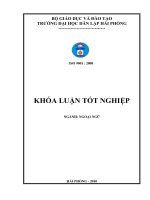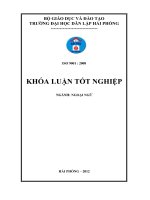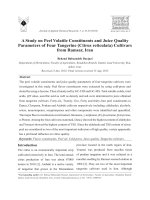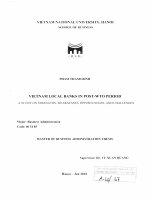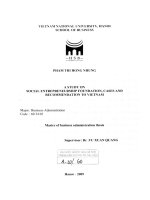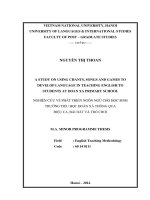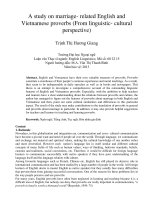A study on summer monsoon season and rainfall characteristics in summer monsoon season over Southern Vietnam in 1981-2014 period
Bạn đang xem bản rút gọn của tài liệu. Xem và tải ngay bản đầy đủ của tài liệu tại đây (501.74 KB, 7 trang )
Journal of Marine Science and Technology; Vol. 17, No. 4B; 2017: 44-50
DOI: 10.15625/1859-3097/17/4B/12963
/>
A STUDY ON SUMMER MONSOON SEASON AND RAINFALL
CHARACTERISTICS IN SUMMER MONSOON SEASON OVER
SOUTHERN VIETNAM IN 1981-2014 PERIOD
Huong Ngo-Thi-Thanh, Hang Vu-Thanh
Faculty of Hydro-Meteorology and Oceanography, Hanoi University of Science, VNU
*
E-mail:
Received: 9-11-2017
ABSTRACT: This study determines the summer monsoon season over Southern Vietnam in
1981-2014 period by using observed daily rain-gauge data and reanalyzed daily 850 hPa wind data.
The results show that the mean onset and retreat dates of summer monsoon over Southern Vietnam
occur on May 15 and October 13, with standard deviations of 14.12 and 13.55 days, respectively.
The results also show that the onset and retreat dates tend to precede in the recent years. In summer
monsoon period, the values of RX1day and RX5day are high in Rach Gia and Ca Mau but low in
Can Tho, CDD of all stations are low. In all stations, the values of extreme rainfall indices in 19982014 period are higher compared to those in 1981-1997 period.
Keywords: Summer monsoon, rainfall indices, Southern Vietnam.
INTRODUCTION
Summer monsoon is marked by drastic
changes from dry season to rainy season,
providing a significant amount of rainfall in
many regions. The changes of the onset and
retreat of summer monsoon and extreme
rainfall phenomena lead to the changes in water
resources which directly significantly affect
agriculture, forestry, fishing, farming, and
traffic…
Nowadays, studies on summer monsoon are
often based on rainfall index [1-4], wind index
[5], or OLR and wind combined index [6].
Zhang et al., (2002) showed that the mean
onset date of summer monsoon over Indochina
in 1951-1996 period was on May 5. Wang et
al., (2002) showed that summer monsoon
rainfall occurred over Indochina in the early
May (pentad 25-pentad 26) and over the East
Vietnam Sea in the middle May (pentad 27pentad 28). Wang et al., (2004) used the zonal
44
wind index at 850 hPa level from NCEP/NCAR
to calculate the monsoon onset over the East
Vietnam Sea. They pointed out that the onset
occurred in middle May (pentad 28). Wang et
al., (2004) and Kajikawa and Wang (2012)
revealed that the summer monsoon onset date
in 1994-2008 period occurred 3 pentads earlier
than that in 1979-1993 period. The retreat date
of two periods both occurred around middle
October. Prasad et al., (2005) showed that
summer monsoon season over Indian in 19582001 period began in late May and June, ended
in late September and October. By combining
OLR and wind, Wei-Dong et al., (2012)
indicated that the mean onset date over the East
Vietnam Sea in 1979-1995 period was May 6
with standard deviation of 13 days.
Southern Vietnam is one of the most clearly
effective areas of summer monsoon. In
addition, water resources in this area strongly
depend on summer monsoon rainfall.
A study on Summer monsoon season…
Therefore, there are several studies on summer
monsoon over Southern Vietnam related to
onset date [7], relationship between rainfall and
ENSO as well as simulated large-scale
circulation in summer monsoon pre-onset [8,
9]. The results of Thanh et al., (2010) showed
that the mean summer monsoon onset date over
Southern Vietnam during 1979-2004 period
occurred on May 12 with standard deviation of
11.6 days. Besides, the rainy onset date in
Southern Vietnam in El Nĩno years occurred
earlier than in La Nĩna years [10].
Overall, a lot of studies on summer
monsoon onset date have been carried out but
those on summer monsoon retreat date are still
limited, especially on extreme rainfall indices
in summer monsoon season. Thus, in this
study, the changes of summer monsoon onset
and retreat dates over Southern Vietnam during
1981-2014 period are examined as well as the
changes of extreme rainfall indices in summer
monsoon season are also carried out.
DATA AND METHODOLOGY
Data
Observed daily rainfall of 4 stations in
Southern Vietnam during 1981-2014 period has
been used in this study. In order to avoid
possible biases, only the year (month) having
more than 330 days (25 days) is included in
rainfall data series. The NCEP/NCAR
reanalyzed daily 850 hPa wind data in 2.5o ×
2.5o grid box is used to calculate the wind
index for a specific year. It is defined as daily
value of 850 hPa zonal wind speed averaged on
the domain extending for about 9oN-11.5oN and
104.5oE-107oE. List of stations over Southern
Vietnam is described in table 1.
Table 1. Stations in the Southern Vietnam
No.
Stations
Lon.
Lat.
No.
Stations
Lon.
Lat.
1
2
Tay Ninh
Can Tho
106.12
105.77
11.33
10.03
3
4
Rach Gia
Ca Mau
105.07
105.15
10.00
9.14
Methodology
Criteria for summer monsoon onset and
retreat dates
The onset (retreat) date of summer
monsoon for a specific year over Southern
Vietnam is determined by 5-day running
rainfall series and the 850 hPa zonal wind
index. The onset (retreat) date must satisfy the
two following conditions: The onset (retreat)
date is the first day out of five continuous days
having total 5 day running rainfall greater than
5 mm. The average daily wind index at 850 hPa
level is greater than 0.5 m/s for 5 continuous
days for onset (retreat) date forward
(backward) [11]. The length of summer
monsoon season is the period from the onset
date to the retreat date of summer monsoon.
Extreme rainfall indices
Table 2 describes some extreme rainfall
indices in this study. Except WD, the remaining
indices follow Peterson et al., (2001) [12].
Table 2. The rainfall indices
No.
Indices
Definitions
Units
1
WD
Annual count of wet days (day where rainfall ≥ 1mm)
day
2
PRCPTOT
Annual total precipitation in wet days
mm
3
SDII
Simple precipitation intensity index: the ratio of PRCPTOT to WD
4
RX1day
Monthly/annual maximum 1-day precipitation
mm
5
RX5day
Monthly/annual maximum consecutive 5-day precipitation
mm
6
R50
Annual count of days where rainfall ≥ 50mm
day
7
CDD
Maximum length of dry spell, maximum number of consecutive days with rainfall < 1 mm
day
8
CWD
Maximum length of wet spell, maximum number of consecutive days with rainfall ≥ 1 mm
day
mm/day
45
Huong Ngo-Thi-Thanh, Hang Vu-Thanh
Sen’s slope method [13] is used to estimate
the trend of the onset (retreat) date of summer
monsoon and rainfall indices. The nonparametric Mann-Kendall test is used to
examine the trend’s statistical significance at
0.05 level [14]. Besides, in order to clarify the
recent trend of summer monsoon onset (retreat)
date and rainfall indices, the 1981-2014 period
is devided into two equal sub-periods 19811997 and 1998-2014. Then, the difference of
the mean onset (retreat) date and rainfall
indices between two sub-periods is calculated.
The Student test is used to examine these
changes with the statistical significance at 0.05
level.
RESULTS AND DISCUSSIONS
The onset and retreat dates over Southern
Vietnam in 1981-2014 period
Table 3 describes the summer monsoon
onset and retreat dates over Southern Vietnam
during 1981-2014 period. Table 3 reveals that
the mean summer monsoon onset and retreat
dates are May 15 and October 13 with standard
deviations of 14.12 days and 13.55 days,
respectively.
Table 3. The summer monsoon onset and retreat dates
over Southern Vietnam during 1981-2014 period
Years
1981
1982
1983
1984
1985
1986
1987
1988
1989
1990
1991
1992
1993
1994
1995
1996
1997
Onset dates
16-May
02-Jun
22-May
24-May
25-Apr
16-May
11-Jun
04-May
16-May
20-May
09-Jun
18-May
05-Jun
08-May
12-May
07-May
16-May
Retreat dates
19-Oct
22-Oct
15-Oct
17-Oct
06-Oct
16-Oct
18-Sep
29-Sep
15-Oct
20-Oct
13-Oct
21-Sep
26-Sep
30-Sep
12-Oct
04-Nov
06-Nov
3000
250
SM_length
Season rainfall (mm)
2500
200
2000
150
1500
100
1000
Season length (days)
SMrain
50
500
0
0
1981
1986
1991
1996
2001
2006
2011
Fig. 1. Total annual summer monsoon rainfall
and summer monsoon season’s length during
1981-2014 period
The summer monsoon onset and retreat
dates tend to occur earlier in the recent years
46
Years
1998
1999
2000
2001
2002
2003
2004
2005
2006
2007
2008
2009
2010
2011
2012
2013
2014
Mean
STDV
Onset dates
26-May
11-May
08-May
11-May
24-May
21-May
14-May
07-May
16-May
07-May
01-May
25-May
05-May
26-May
25-Apr
07-Jun
12-May
15-May
14.12
Retreat dates
19-Oct
08-Nov
17-Oct
11-Oct
25-Sep
01-Oct
19-Sep
08-Oct
15-Oct
06-Oct
02-Nov
18-Nov
16-Nov
14-Oct
09-Oct
11-Oct
11-Oct
13-Oct
13.55
with the Sen coefficients of 3.3 days and 1.76
days per decade. However, all tendency values
are statistically non-significant at 0.05 level.
The summer monssoon onset and retreat dates
in 1998-2014 period occur earlier respectively
about 6 days and 1 day compared to 1981-1997
period.
The variation of total annual summer
monsoon rainfall (SM rain) and summer
monsoon season’s length (SM_length) over
Southern Vietnam during 1981-2014 period are
plotted in fig. 1. In general, total summer
monsoon rainfall changes from less than 800
mm (in 1987) to more than 2000 mm (in 1999).
A study on summer monsoon season…
The shortest summer monsoon season’s lengh
and the smallest total rainfall occur in 1987 in
accordance with El Niño phenomenon. In
contrast, the longest summer monsoon season’s
lengh and the highest total rainfall are observed
in 1999 in agreement with La Nĩna
phenomenon. These results are consistent with
the study of Thuan et al., (2007). The total
rainfall in summer monson season is highly
correlated with the length of summer monsoon
season with correlation coefficient of 0.83. The
averaged summer monsoon season’s length
over Southern Vietnam in 1981-2014 period is
152 days. Besides, the results also show that
the onset and retreat dates of summer monsoon
are significantly correlated with total summer
monsoon rainfall with coefficients of -0.55 and
0.81, respectively.
Changes in extreme rainfall indices
Figure 2 illustrates some statistical
characteristics of extreme rainfall indices in
summer monsoon season over Southern
Vietnam during 1981-2014 period.
Fig. 2. Box plots of extreme rainfall indices in summer monsoon season
at each station during 1981-2014 period
47
Huong Ngo-Thi-Thanh, Hang Vu-Thanh
It can be seen that PRCPTOT and SDII are
high at Rach Gia and Ca Mau but low at Can
Tho. The highest value of PRCPTOT is
2597.2 mm at Rach Gia recorded in 1999 while
the lowest one is 612.9 mm recorded at Tay
Ninh in 1987. The maximum value of RX1day
is 260.5 mm in 1982 and that of RX5 day is
410.2 mm in 2003 at Rach Gia. WD varies
from 75 to 100 days. WD can reach 137 days at
Ca Mau in 1999. R50 varies from 2 to 8 days at
4 stations. The highest value of R50 is 13 days
in 1999 at Rach Gia. The averaged value of
CDD is 7 days. Meanwhile, CWD strongly
changes among years and stations. CWD values
at Can Tho are the lowest values compared to
other stations.
Fig. 3. Sen’s slope of rainfall indices at each station during 1981-2014 period. Unit: %/10 year (a)
and day/10 year (b). The hatched pattern indicates the trend is statistically significant at 0.05 level
Fig. 3 indicates the trend of extreme rainfall
indices in summer monsoon season represented
by Sen coefficient. The trends of RX1day,
RX5day, SDII, PRCPTOT decrease at most of
stations except for RX5day at Ca Mau and SDII
at Tay Ninh. The decreasing trends of SDII and
PRCPTOT satisfy statistical significance at 0.05
level. In almost all the stations, WD shows a
significantly downward tendency while R50,
CDD, CWD show little changes.
Fig. 4. The differences of rainfall indices between two sub-periods 1998-2014 and 1981-1997 over
Southern Vietnam. The hatched pattern indicates the trend is statistically significant at 0.05 level
48
A study on summer monsoon season…
Fig. 4 indicates the differences of rainfall
indices in summer monsoon season between
two sub-periods 1998-2014 and 1981-1997
over Southern Vietnam. In summer monsoon
season, CDD at Tay Ninh in 1998-2014 period
is higher than that in 1981-1997 period
(2 days/year). Meanwhile, R50 and CWD at
Can Tho in the later period are lower than those
of the previous one and both have statistical
significance at 0.05 level. In almost all the
stations, RX5day, RX1day, SDII, PRCPTOT
and WD in the later period are lower than those
in the previous one.
CONCLUSIONS
In this study, the observed daily rain-gauge
data and reanalyzed daily 850 hPa wind data
are used to determine the onset and retreat
dates of summer monsoon over Southern
Vietnam during 1981-2014 period. The results
show that the mean onset and retreat dates of
summer monsoon over Southern Vietnam occur
on May 15 and October 13 with standard
deviations of 14.12 and 13.55 days,
respectively. The results also show that the
onset and retreat dates tend to precede in the
recent years. The onset date, retreat date and
length of summer monsoon season are
significantly correlated with the total summer
monsoon rainfall with the coefficients of -0.55,
0.81 and 0.83, respectively.
In the summer monsoon period, values of
RX1day and RX5day are high in Rach Gia and
Ca Mau but low in Can Tho, CDD of all
stations are low. The values of extreme rainfall
indices in 1998-2014 period are higher than
those in 1981-1997 period at all stations.
REFERENCES
1. Zhang, Y., Li, T., Wang, B., and Wu, G.,
2002. Onset of the summer monsoon over
the Indochina Peninsula: Climatology and
interannual variations. Journal of Climate,
15(22), 3206-3221.
2. Wang, B., 2002. Rainy season of the AsianPacific summer monsoon. Journal of
Climate, 15(4), 386-398.
3. Cook, B. I., and Buckley, B. M., 2009.
Objective determination of monsoon season
onset, withdrawal, and length. Journal of
Geophysical
Research:
Atmospheres,
114(D23).
4. Kajikawa, Y., and Wang, B., 2012.
Interdecadal change of the South China Sea
summer monsoon onset. Journal of
Climate, 25(9), 3207-3218.
5. Wang, B., Zhang, Y., and Lu, M. M., 2004.
Definition of South China Sea monsoon
onset and commencement of the East Asia
summer monsoon. Journal of Climate,
17(4), 699-710.
6. Wei-Dong, Y. U., Kui-Ping, L. I., Jian-Wei,
S. H. I., Lin, L. I. U., Hui-Wu, W. A. N. G.,
and Yan-Liang, L. I. U., 2012. The onset of
the monsoon over the Bay of Bengal: The
year-to-year variations. Atmospheric and
Oceanic Science Letters, 5(4), 342-347.
7. Thanh, P. X., Fontaine, B., and Philippon,
N., 2010. Onset of the summer monsoon
over the southern Vietnam and its
predictability. Theoretical and Applied
Climatology, 99(1-2), 105-113.
8. Tuan, B. M., Truong, N. M., 2010: The
characteristics of large-scale circulation
during the monsoon onset period over
Southern Vietnam in 1998. Journal of
Natural Sciences and Technology, Vietnam
National University, Hanoi, 26(3S), 470-478.
9. Truong, N. M., Tuan, B. M, Thanh, C., Hai,
B. H., Van, H. T., 2011. Thermal and moist
large-scale processes during the monsoon
onset period over Southern Vietnam in
2004. Journal of Natural Sciences and
Technology, Vietnam National University,
Hanoi, 27(3S), 254-265.
10. Thuan, N. T. H., Quynh, C. K., 2007.
Validating the main feature variations of
summer rainfall over the Southern Vietnam
in ENSO-years. Proceedings of the 10th
Scientific Conference, Institute of HydroMeteorology and Environment, pp. 314-322.
11. Ngo-Thanh, H., Ngo-Duc, T., NguyenHong, H., Baker, P., and Phan-Van, T.,
2017. A distinction between summer rainy
season and summer monsoon season over
the Central Highlands of Vietnam.
Theoretical and Applied Climatology, 1-10.
49
Huong Ngo-Thi-Thanh, Hang Vu-Thanh
12. Peterson, T., Folland, C., Gruza, G., Hogg,
W., Mokssit, A., and Plummer, N., 2001.
Report on the activities of the working
group on climate change detection and
related rapporteurs. Geneva: World
Meteorological Organization, 143 pp.
50
13. Sen, P. K., 1968. Estimates of the
regression coefficient based on Kendall's
tau. Journal of the American Statistical
Association, 63(324), 1379-1389.
14. Kendall, M. G. (1955). Rank correlation
methods. Charles Griffin, London, 272 p.

